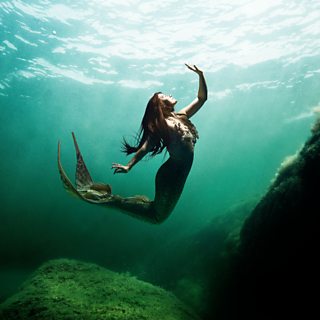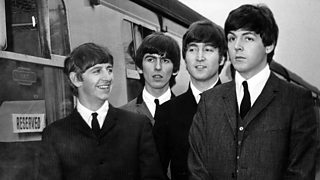Nine of the most memorable mermaids on screen
The mermaid has been a cinematic staple since the turn of the 20th Century, and continues to inspire reflections on gender, sexuality and movement.
To celebrate the 40th anniversary of the romantic comedy hit Splash starring Tom Hanks and Daryl Hannah, in an aquatic episode of Βι¶ΉΤΌΕΔ Radio 4's Screenshot, hosts Ellen E Jones and Mark Kermode explore the rich history of mermaids on screen, from the silent era and the golden age of the sumptuous Hollywood 'aquamusical' to the terrifying fanged versions seen in the 21st Century Polish horror musical The Lure.
Here is a quick dip into the world of mermaids on screen, celebrating some of the most memorable fishy people to have made a splash in the world of cinema.

The Mermaid
It is no surprise that mermaids feature in several of the early magical films of cinema pioneer Georges Méliès, obsessed as he was with fantasy and sorcery. In his 1904 ‘trick’ film The Mermaid, a conjurer produces a mermaid on screen, transforming her into a real woman.
Critic Savina Petkova reflects that the film, “gives us a really good insight into how mermaids have been perceived in cinema as something exotic, something that is there for our entertainment and something to look at.”
A Daughter of the Gods
The first mermaid spectacular, and precursor to the ‘aquamusical’ genre, celebrated the water-based talents of Australian actress Annette Kellerman. 1916’s A Daughter of the Gods, written and directed by Herbert Brenon, was the first American picture to cost more than a million dollars, and featured over 200 mermaids swimming in synchronisation with Kellerman.
Critic Lillian Crawford says: “Tragically the film is lost, but there are some amazing stills of these sequences of Kellerman jumping off waterfalls. She was known for incredibly dangerous stunts, which very much would not be allowed to be performed today, including jumping into a pool of crocodiles.”
Miranda
One of the films which launched the career of the late, great Glynis Johns with her distinctive, sultry voice, Miranda is a light 1948 comedy about a mermaid who falls in love with a married man, played by David Tomlinson.
Savina Petkova has a theory on why these mermaid stories appealed to audiences after the Second World War: “I can see it as a way out of noir structure, a bit more lighthearted. The mermaid is this alluring figure that represents a desired world.”
Mr Peabody and the Mermaid
This mermaid tale, also about a married man flirting with the idea of an affair, was released in the same year as a Miranda. Tomlinson’s debonair philanderer is played here by William Powell, with the seductive mermaid portrayed by Ann Blyth. As ever, the mermaid represents such a man’s idea of an ideal woman - young enough to be his daughter, unable to run away and completely mute. By the end of the film it seems he fabricated the whole thing as part of a classic male mid-life crisis.

Whenever you have a mermaid in a story, there is the potential for subversiveness. There is the potential for something that is talking about otherness.Mark Kermode
Million Dollar Mermaid
Inspired by the life and career of Annette Kellerman, 1952’s Million Dollar Mermaid is perhaps the most visually dazzling film of Esther Williams’s career. Herself known as ‘The Million Dollar Mermaid’, Williams seldom appeared as an actual mermaid in her films, although with her ability to act to camera underwater she deserves to be placed on this list.
And nothing is more memorable than the film’s ending. According to Crawford: “There are people coming down enormous waterslides. There's these giant swings through coloured smoke diving into the water. It really is one of the most spectacular sequences in cinema.”
Splash
Released as the first Disney film under the Touchstone Pictures label targeting adult audiences, Splash combines the childish appeal of mermaids with grown-up themes of romance and sexuality. In this classic 1984 comedy Darryl Hannah plays the literal fish-out-of-water Madison who falls in love with human Allen played by Tom Hanks.
Ellen is critical of the film, saying it is “essentially about emasculated men reasserting their power by disempowering women”, while Mark Kermode sees it as “a very deliberate inversion of the standard mermaid story. I think what it tells us is that whenever you have a mermaid in a story, there is the potential for subversiveness. There is the potential for something that is talking about otherness.”
The Little Mermaid
No discussion of mermaids would be complete without mentioning Hans Christian Andersen’s fairytale, and its most famous adaptation as an animated children’s film by Disney in 1989. The teenage mermaid princess Ariel, voiced by Jodi Benson, is perhaps the most-beloved of all merpeople, especially through her iconic musical numbers including Part of Your World.
Crawford sees the visual power of The Little Mermaid as coming from the legacy of Esther Williams, saying that Disney was able to “take those incredible live-action feats of underwater acrobatics and turn them into something even more spectacular through animation.”
The Lure
Agnieszka SmoczyΕ„ska’s 2015 Polish horror film The Lure is very much the anti-Disney mermaid musical. Transposing Andersen’s fairytale to the seedy nightlife of late 1980s Warsaw, here the mermaids are strippers and backing singers, bearing not the sexy fish-like tails of yore but reimagined as enormous, dragon-like monstrosities replete with fangs and scales.
Reflecting on this aesthetic choice, SmoczyΕ„ska says: “We decided to make the mermaids a metaphor for growing up as girls. It represents to me a metaphor of somebody who is between childhood and adolescence. It means that you are half girl, half child, half a woman. It’s somebody who is in-between.”
Hail, Caesar!
One of the greatest homages to mermaids and the aquamusical in modern cinema comes in the Coen Brothers’ epic 2016 Hollywood-studio pastiche Hail, Caesar! The film stars Scarlett Johansson as DeeAnna Moran, an Esther Williams-like actress who plays a mermaid in a water ballet sequence while hiding her pregnancy from the crew.
MΔ“sha Kussman, founder of the Aqualillies troupe who performed the sequence with Johansson, says: “We trained Scarlett Johansson in the mermaid tale. She had a mono fin in the workshops and she was totally unafraid and completely capable because she's a Marvel adventure hero so she can do anything.”
To hear more about Mark and Ellen's adventures under the sea, listen to the episode in full on Βι¶ΉΤΌΕΔ Sounds.
More articles from Screenshot
-
![]()
Eight of the most memorable pop star portrayals on screen
Pop idol stories that struck a chord with us in film and on TV.
-
![]()
Eight of cinema's greatest love triangles
Caspar Salmon runs through eight of the steamiest examples in cinema.
-
![]()
Seven of Meryl Streep's greatest ever roles
The most important performances of the iconic star's career so far.
-
![]()
Seven of cinema's most memorable outlaw couples
On the trail of the law-breaking lovers who lit up our screens.





